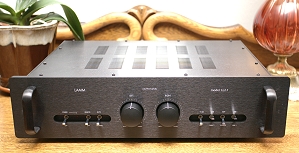Introduction
Lamm Industries has been a venerable brand name in high end audio for decades. They build each product when it is ordered, so you won’t see a bunch of any particular model “in stock” anywhere. Their specialty is tube-based preamplifiers and power amplifiers, with their top-of-the-line power amplifier selling at well over $100,000. The current review focuses on the model LL2.1 stereo preamplifier. At $5,990, it is the most affordable preamplifier in the Lamm product line.
The LL2.1 is an updated version of a previous model. Several new features have been added along with modifications of the basic circuit.
Specifications
- Design: Pure Class A Stereo Tube Preamplifier
- Tube Compliment: Two 12AU7A, Two 6DJ8, One 6X4
- Maximum Output Voltage: Typically 60 Volts RMS
- MFR: 20 Hz – 20 kHz, ± 0 dB
- THD+N: 0.03%
- Inputs and Outputs: RCA Unbalanced
- Input Impedance: 50 kOhms
- Output Impedance: 250 Ohms
- Input Sensitivity: 0.127 Volts (Produces Output of 1 Volt RMS)
- S/N: < 84 dB below 2 Volts Output RMS
- Dimensions: 4.5″ H x 19″ W x 13.9″ D (The Handles Protrude an Additional 1.4″)
- Weight: 20 Pounds
- MSRP: $5,990 USA (Deluxe Version), $5,690 (Standard Version)
- Lamm Industries
The Design
The LL2.1 comes in two versions, the Deluxe and the Standard. The Deluxe has two additional power supply capacitors, and additional capacitors in parallel with the standard capacitors in a certain part of the signal path. Both versions have a new On/Off jack on the rear panel that connects to other Lamm products so that you only have to turn one On/Off switch to power a complete audio system. There is also a new 15 dB attenuation switch which gives you more room in the volume control should your power amplifiers and/or speakers have high sensitivity. The knobs on the front are also different.

There are three sets of stereo inputs, Line 1, Line 2, and Direct. The Direct mode passes the signal from the input to the volume control and then to the output, without preamplification. Two sets of outputs and a tape loop complete the layout. All of the RCA jacks are very heavy copper with gold plating.
The inside of the chassis is very simple, and consumers sometimes think, “Wow, there is not much in there for such an expensive product.” But you see, that is the basis of a great audio product. Having the least amount of parts in the signal path is the key to good sound, because there are less items to degrade the signal.

In the photo above, the red arrows indicate two 12AU7’s, which are the first amplification stage, the yellow arrows indicate two 6DJ8’s, which are the second stage. Rectification (changing the incoming AC to DC) is performed by a third tube, a 6X4 (blue arrow). Smoothing the power after it is rectified is performed by the blue capacitors just to the right of the 6X4.
The LL2.1 operates in Pure Class A, Single-Ended, which to high end audio aficionados, is a heavenly specification.
In Use
I tested the LL2.1 with a McIntosh MCD500 SACD player, Lamm M2.2 monoblock power amplifiers, and Carver Amazing Mark IV ribbon speakers. Cables were Legenburg and Emotiva.
A lot of tube audio equipment tends to roll off at the top and bottom of the audible spectrum. Not so with Lamm products. The top is crystal clear, and it is obvious that you are getting everything that is on the CD or SACD with such instruments as a triangle, whose harmonics go way up there in frequency. And a triangle is not easy to hear in the middle of a powerful classical piece, not only because it plays softly, but also it will be buried if the preamp or power amplifier has midrange congestion (due to high IMD).
Neither was there any apparent loss of the deep bass. The huge drum that opens Copland’s Fanfare for the Common Man (Telarc) made the light fixture in the right rear corner rattle (I have to fix that with some putty). This is probably my favorite recording of all time (I suspect you already know that because I use it so often in reviews). It was originally released as a CD more than 20 years ago, and then, just a few years ago, Telarc released it in SACD format because the original recording was done at 50 kHz sample rate, rather than 44.1 kHz, so there was something to be gained by releasing it in all its full glory.
On the same disc is Rodeo, and the crack of a whip occurs during one of the tracks. Its crispness, clarity, and detail made it obvious that the Lamm LL2.1 was not holding anything back.
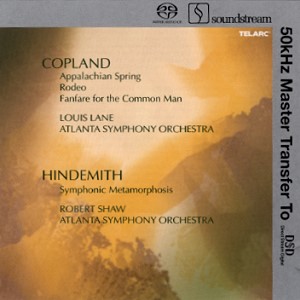
For voices, I chose Mary Chapin Carpenter’s Come On Come On, which I listened to using the LL2.1 with great relish. When a musician is gifted, what a waste it is to play their recordings with less capable gear. The LL2.1 gave me everything I could ever hope for.

Tchaikovsky had breath-taking talent. He could have made a fortune writing musical scores for movies. Ah, what could have been! Anyway, one particular piece, the Serenade for Strings, is a tough one for any amplifier, as the violins span several octaves and has tremendous harmonic content. Any amplifier with midrange congestion would produce mush with such music, but the LL2.1 delivered every nuance for each instrument with a grace and ease that . . . well, what can I say, I expected it to perform this way, because it is a Lamm.

On the Bench
Distortion measurements were within an 80 kHz bandwidth. Except where noted, the yellow graph line represents the left channel, and red is the right channel.
At 1 kHz and 2 volts output, THD+N was a mere 0.008%. I did note some high frequency noise in the 20 kHz range at about – 90 dBV, which would be inaudible, and it is lower than the – 84 dB noise level below a 2 volt signal specified by Lamm.
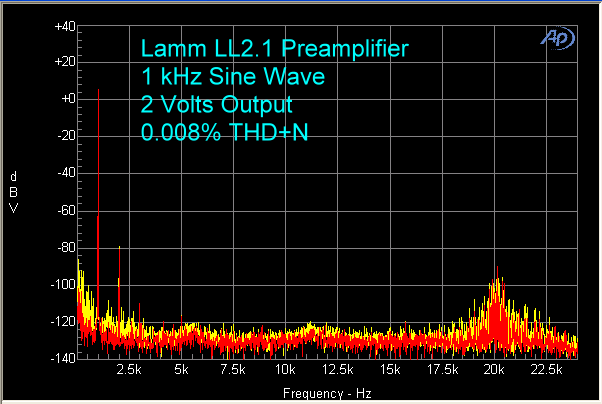
At 10 kHz, distortion rose a bit, which is not unusual.
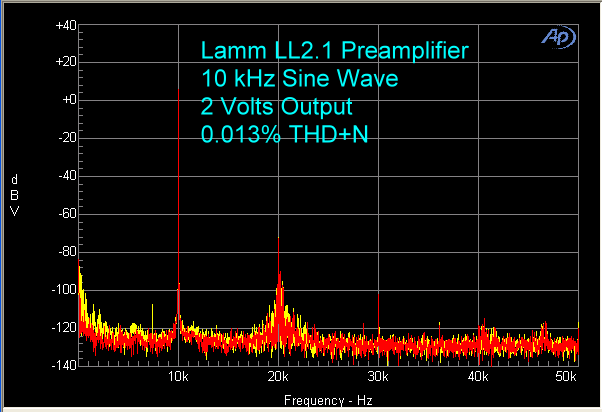
Using 19 kHz and 20 kHz as the test signal, the B-A peak at 1 kHz was 66 dB lower than the fundamentals.

IMD was 0.02%, using 60 Hz and 7 kHz as the test signal.
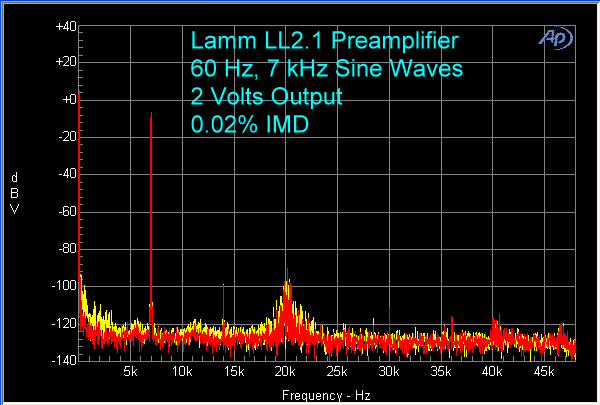
The measured frequency response was 20 Hz to 20 kHz, flat. It rolled off 2 dB by 200 kHz. Using a 600 ohm load resulted in a severe bass rolloff below 400 Hz. However, one would never encounter this type of load in the real world.
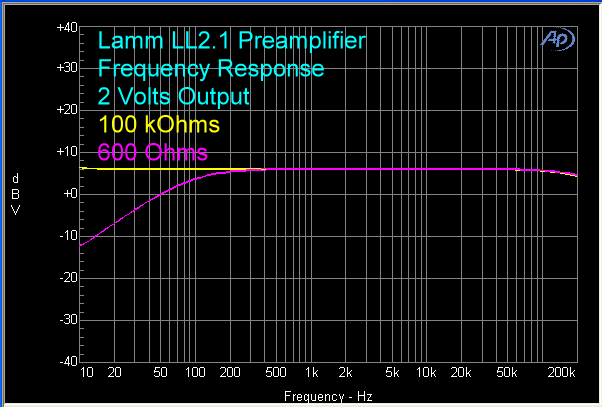
THD+N vs. Frequency showed a flat response out to about 3 kHz, then rising to 0.07% at 50 kHz. This is excellent performance!
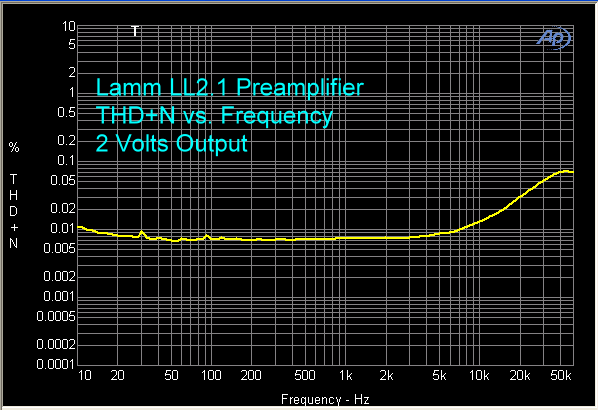
The measured output indicated a knee at 2 volts, then rising to a second knee at 70 volts before going into clipping (1% THD+N) at 80 volts. This is a very powerful preamplifier. It means that during transients, which may demand quite a bit of voltage (they last a few milliseconds, at the beginning of a steel guitar string pluck, or a gunshot for example), the Lamm will not falter. Again, the 600 ohm load shows definite stress, even though it does not really mean much. Other publications show component performance with this load, so we might as well do it too. But, I wish Audio Precision would add a 10 kOhm load and a 47 kOhm load to the menu options. Those are more likely to be encountered than 100 kOhms or 600 ohms.
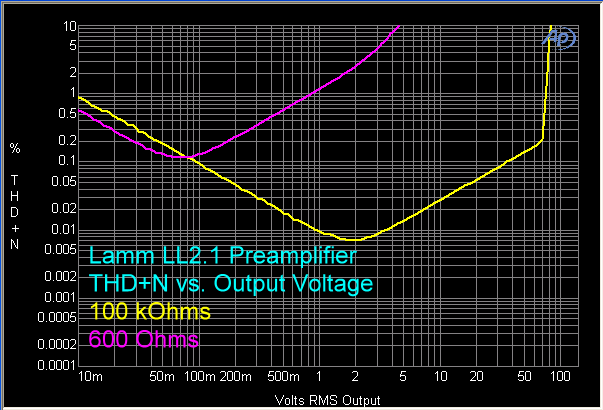
Conclusions
In absolute terms, $6,000 for a preamplifier seems like a lot of money, and it is. But, I paid almost $3 for a loaf of bread the other day. It was really good, and worth the higher price. So is the Lamm LL2.1 Deluxe Stereo Tube Preamplifier. You get what you pay for, and although it may seem like levity, I think you are getting a little more than you pay for with this product.



